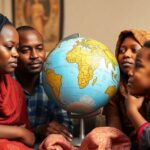Norway has long been known for its progressive stance on human rights and immigration. However, recent whispers about the potential existence of undisclosed quotas on Nigerian immigrants have raised eyebrows. This article digs into Norway’s immigration policies, the role of quotas, and the impact of secrecy on those seeking a better life in this Nordic country. With many questions still unanswered, we aim to shed light on this significant issue.
Key Takeaways
- Norway has a complex history with immigration, shaped by various policies over the years.
- Allegations of undisclosed quotas for Nigerian immigrants are raising concerns about transparency and fairness.
- The psychological and economic effects of uncertainty can deeply impact immigrant communities.
- Comparative studies show that other Scandinavian countries handle immigration differently, which could offer lessons for Norway.
- Grassroots movements and NGOs are crucial in advocating for immigrant rights and pushing for more transparency in immigration policies.
Understanding Norway’s Immigration Policies
Historical Context of Immigration in Norway
Looking back, Norway wasn’t always a hotspot for immigrants. For a long time, it was a pretty homogenous place. But things started changing, especially after World War II. The need for labor grew, and people from other countries started coming in. At first, it was mostly folks from other European countries, but later on, people from all over the world began to arrive. It’s interesting to see how these waves of immigration have shaped Norway into what it is today. The country’s approach to immigration has evolved significantly over the decades.
Current Immigration Trends
These days, immigration to Norway is a complex thing. You’ve got people coming for all sorts of reasons: work, family, asylum. What’s interesting is how the numbers fluctuate depending on what’s happening in the world. Economic changes, political situations – they all play a part. And it’s not just about the numbers; it’s about where people are coming from. There’s been a noticeable shift in the countries of origin over the years. Understanding these trends is key to grasping the current state of affairs.
Legal Framework Governing Immigration
Okay, so how does Norway actually manage all this? Well, there’s a whole bunch of laws and regulations in place. The Immigration Act is a big one, setting out the rules for who can come in, how long they can stay, and what rights they have. It’s not always easy to understand, though. There are different categories of permits, each with its own set of requirements. And things can change, too, as the government tweaks the rules to respond to new challenges. It’s a system that’s constantly being updated and revised.
Navigating Norway’s immigration laws can feel like trying to solve a puzzle with missing pieces. The regulations are extensive, and understanding them often requires expert help. This complexity can be a significant barrier for immigrants trying to build a new life in Norway.
Here’s a quick look at some key aspects of the legal framework:
- The Immigration Act
- Regulations on asylum
- Rules for family reunification
- Work permit requirements
The Role of Quotas in Immigration
What Are Immigration Quotas?
So, what exactly are we talking about when we say immigration quotas? Basically, it’s a limit set by a country on how many immigrants they’ll allow in, usually within a specific time frame, like a year. These quotas can be broad, covering all immigrants, or they can be very specific, targeting certain nationalities, skill sets, or family connections. The main idea behind a quota is to manage the flow of people coming into a country. It’s a tool governments use to try and control population growth, labor market needs, and even cultural integration. It’s not always a straightforward thing, and the numbers can change based on a country’s current situation and political climate.
How Quotas Affect Immigrant Communities
Quotas can really shake things up for immigrant communities. Think about it: if a country suddenly cuts the number of visas available for a particular nationality, it can split families apart. People who were planning to move might have to put their lives on hold, and those already here might worry about their loved ones joining them. It also affects the diversity within these communities. If quotas favor certain skills or education levels, it can change the makeup of who gets to immigrate. This can lead to some groups feeling left out or underrepresented. It’s a complex situation with a lot of emotional and practical consequences.
The Debate Over Quota Transparency
One of the biggest arguments around immigration quotas is whether they should be public knowledge. Some people argue that transparency is key. They believe everyone has a right to know how the system works, so they can plan accordingly and hold the government accountable. Others say that revealing the exact numbers could lead to political pressure or even discrimination. They might argue that keeping some details private allows for more flexibility in responding to changing circumstances.
It’s a tough call. On one hand, secrecy breeds mistrust and makes it harder for people to navigate the immigration system. On the other hand, complete openness might create new problems and unintended consequences. Finding the right balance is a real challenge.
Here are some points to consider:
- Transparency builds trust.
- Secrecy can lead to unfair practices.
- Public knowledge allows for informed debate.
Nigerian Immigrants in Norway
Demographics of Nigerian Immigrants
Okay, so let’s talk about Nigerians in Norway. It’s not a huge group, but it’s definitely a growing one. From what I’ve seen, most Nigerian immigrants are in the bigger cities like Oslo and Bergen. They’re a pretty diverse bunch, with different levels of education and reasons for moving. Some come for work, others for family, and some, unfortunately, as asylum seekers. It’s interesting to see how this community is changing the face of Norway, even if it’s still relatively small. Understanding the Immigration Act Section 28 is key to understanding their status.
Challenges Faced by Nigerian Immigrants
Life isn’t always easy when you move to a new country, and Nigerian immigrants in Norway are no exception. One of the biggest hurdles is definitely the language barrier. Norwegian is tough! Then there’s the whole cultural adjustment thing. It can be hard to get used to the Norwegian way of doing things, which is often very different from what they’re used to. Finding a job can also be a struggle, especially if their qualifications aren’t recognized or if they face discrimination. It’s a tough situation, and I think it’s important to acknowledge these challenges.
- Language barriers
- Cultural differences
- Employment difficulties
Contributions of Nigerian Immigrants to Norwegian Society
Despite the challenges, Nigerian immigrants are making some real contributions to Norwegian society. I’ve noticed they’re active in a bunch of different fields, from healthcare to African Studies. Many are entrepreneurs, starting their own businesses and creating jobs. And let’s not forget the cultural impact – they’re bringing new perspectives, traditions, and flavors to Norway. It’s easy to see that they’re adding to the richness and diversity of the country.
It’s important to remember that immigrants aren’t just taking from society; they’re also giving back in so many ways. They bring skills, ideas, and a willingness to work hard, which can benefit everyone.
Allegations of Quota Secrecy
Recent Reports on Quota Secrecy
Lately, there’s been a growing buzz about whether Norway is quietly using quotas to limit the number of immigrants it accepts, specifically from Nigeria. It’s tough to say for sure, but several reports have started to surface suggesting that while Norway’s official immigration policies seem open and fair, the reality might be different. These reports often come from immigrant advocacy groups and some investigative journalists who’ve noticed a pattern: a surprisingly high number of Nigerian applicants being denied visas or residency permits, even when they appear to meet all the stated requirements. This discrepancy has led to suspicions that there are unofficial, undisclosed quotas at play.
Government Responses to Allegations
So, what does the Norwegian government say about all this? Well, predictably, they deny everything. Officials usually respond to these allegations by stating that all immigration decisions are made strictly according to the law and individual circumstances. They emphasize Norway’s commitment to treating all applicants fairly and without discrimination. However, they often avoid directly addressing the specific claims of quota secrecy, which makes people even more suspicious. It’s like they’re saying, "We follow the rules," but not really explaining how they follow the rules in each specific case.
Implications for Immigrant Rights
If these allegations are true, the implications for immigrant rights are pretty serious. Here are some of them:
- It undermines the principle of transparency and fairness in immigration procedures.
- It creates a climate of uncertainty and anxiety for potential immigrants.
- It makes it difficult for immigrants to challenge decisions, as the real reasons for rejection are hidden.
The lack of transparency erodes trust in the system and can lead to feelings of injustice and discrimination among those seeking to build a life in Norway.
Ultimately, the secrecy surrounding these alleged quotas raises questions about Norway’s commitment to human rights and its international obligations. If a country is going to limit immigration, shouldn’t it be open and honest about it?
The Impact of Secrecy on Immigrant Lives
Psychological Effects of Uncertainty
Living under a cloud of uncertainty is tough. Imagine trying to build a life in a new country, but you’re always wondering if there’s some invisible barrier holding you back. This is the reality for many Nigerian immigrants in Norway, where alleged quota secrecy creates a constant state of anxiety. The lack of transparency breeds distrust and makes it difficult to plan for the future. It’s like trying to run a race when you don’t know where the finish line is. You might start strong, but eventually, the uncertainty will wear you down. This can lead to:
- Increased stress levels
- Feelings of isolation and alienation
- Difficulty integrating into Norwegian society
Economic Consequences for Immigrants
Secrecy in immigration policies doesn’t just mess with your head; it hits your wallet too. If you don’t know the rules of the game, how can you play it effectively? This lack of clarity can lead to economic instability for immigrants. For example, if an immigrant invests time and money into education or training, hoping to secure a job, only to be denied residency due to an undisclosed quota, that’s a significant financial setback. It also affects their ability to:
- Secure stable employment
- Access financial services
- Start businesses and contribute to the Norwegian economy
Social Integration Challenges
Social integration is hard enough when everyone is playing by the same rules. But when there’s a perception of hidden quotas, it creates a sense of otherness and exclusion. It’s like being at a party where you don’t know the dress code – you feel out of place and unsure of yourself. This can lead to:
- Difficulty building relationships with Norwegians
- Increased risk of discrimination
- Reduced participation in community activities
The feeling of not knowing where you stand can be incredibly disempowering. It makes it difficult to feel like you truly belong and can hinder your ability to fully contribute to your new home.
Ultimately, the alleged secrecy surrounding immigration quotas in Norway creates a system where immigrants are forced to navigate a maze without a map. It’s time for transparency and fairness, so everyone has a fair shot at building a good life.
Comparative Analysis of Immigration Policies
Norway vs. Other Scandinavian Countries
When we look at Norway’s immigration approach compared to its Scandinavian neighbors – Sweden, Denmark, and Finland – some interesting differences pop up. Each country has its own unique history, which shapes its policies. For example, Sweden has historically had a more open approach, while Denmark has adopted stricter regulations in recent years. Norway seems to be somewhere in the middle, but with its own set of challenges, especially given the allegations we’re exploring. It’s not just about numbers; it’s about how immigrants are integrated into society, the support they receive, and the overall social climate. Understanding these nuances is key to seeing where Norway stands.
Global Perspectives on Immigration Quotas
Stepping back and looking at immigration quotas globally, you see a real mix of approaches. Some countries, like Canada and Australia, have formal, points-based systems that are pretty transparent. Others rely on more informal mechanisms, which can be harder to track and understand. The US has a complex system with various visa categories and quotas, often leading to backlogs and frustrations. What’s interesting is how different countries balance their economic needs, humanitarian concerns, and social integration goals when setting these quotas. It’s a constant balancing act, and there’s no one-size-fits-all solution. The effectiveness of these quotas also varies widely, depending on factors like enforcement, economic conditions, and public opinion. It’s a complex web of factors that all play a role.
Lessons from Other Nations
So, what can Norway learn from other countries’ experiences with immigration policies? Plenty, I think. For starters, transparency is huge. Countries with clear, well-defined quota systems tend to have better outcomes in terms of public trust and immigrant integration. Also, investing in integration programs – language training, job skills development, cultural orientation – can make a big difference in how well immigrants adapt and contribute to their new home. Finally, it’s important to have open and honest conversations about immigration, addressing concerns and dispelling myths. No country has it all figured out, but by learning from each other, we can hopefully create more fair and effective immigration systems. The rise of immigration in Norway is a key factor to consider.
It’s clear that there’s no perfect model for immigration policy. Each country faces its own unique set of challenges and opportunities. The key is to find a balance between national interests, humanitarian concerns, and the well-being of immigrants themselves. This requires ongoing dialogue, adaptation, and a willingness to learn from both successes and failures.
Advocacy and Activism
Grassroots Movements for Transparency
When people feel unheard, they start to organize. That’s what I’ve seen happening with the Nigerian immigrant community in Norway. It’s not always big, flashy demonstrations. Sometimes it’s just small groups meeting in community centers, sharing stories, and figuring out how to make their voices louder. They use social media, local newsletters, and word-of-mouth to spread awareness. It’s about building power from the ground up. These movements often start with a single, shared frustration but quickly evolve into organized efforts demanding accountability.
Role of NGOs in Immigration Advocacy
Non-governmental organizations (NGOs) play a vital role. They often have the resources and expertise to navigate complex legal and political systems. They can provide legal aid, language support, and cultural orientation programs. More importantly, they can advocate for policy changes at a higher level, engaging with government officials and international bodies. It’s a partnership, really. The grassroots movements provide the stories and the energy, and the NGOs provide the structure and the access.
Success Stories of Immigrant Advocacy
It’s easy to feel like nothing is changing, but there have been small wins. I remember one case where an NGO helped a family appeal a deportation order based on a misinterpretation of immigration law. It took months, but they won. These victories, while small, show that advocacy can work. They inspire others to keep fighting. It’s about chipping away at the system, one case, one policy change at a time. The fight for free movement continues.
Advocacy isn’t always about grand gestures. Sometimes, it’s about the quiet persistence of individuals and organizations working together to create a more just and equitable society. It’s about amplifying voices that are often marginalized and holding power accountable.
Here’s a simple breakdown of how advocacy efforts can lead to change:
- Raising Awareness: Educating the public and policymakers about the issues.
- Building Coalitions: Connecting different groups to work together.
- Lobbying: Engaging with government officials to influence policy.
- Legal Action: Challenging discriminatory laws in court.
Media Coverage of Immigration Issues
How Media Shapes Public Perception
Media outlets play a big role in how people see immigration. The stories they choose to tell, the language they use, and the angles they take all influence public opinion. For example, if news reports focus mainly on negative aspects, like crime or economic strain, people might develop a more negative view of immigrants. On the other hand, stories that highlight the contributions and successes of immigrants can shape public perception in a more positive way. It’s not always a conscious thing, but the media’s choices definitely matter.
Investigative Journalism on Immigration Quotas
Digging into the details of immigration policies, especially alleged secret quotas, requires serious investigative work. Journalists need to find sources, analyze data, and often fight for access to information that governments might prefer to keep quiet. This kind of reporting is essential for holding authorities accountable and ensuring transparency. The Financial Times and the New York Times are examples of media that have done extensive reporting on immigration issues. It’s not easy work, but it’s important for informing the public and sparking debate.
The Role of Social Media in Advocacy
Social media has become a powerful tool for advocacy groups and individuals to share their stories and organize campaigns. It allows people to bypass traditional media outlets and speak directly to the public. Immigrants and their supporters can use platforms like Twitter, Facebook, and Instagram to raise awareness about issues, challenge negative stereotypes, and mobilize support for policy changes. Social media also helps connect people who might feel isolated and provides a space for sharing information and resources. It’s a game-changer for immigration advocacy.
Social media’s impact on immigration discourse is undeniable. It provides a platform for marginalized voices, facilitates rapid information dissemination, and enables the formation of online communities that transcend geographical boundaries. However, it also presents challenges, including the spread of misinformation and the amplification of hateful rhetoric, requiring careful navigation and critical engagement.
Here are some ways social media helps:
- Sharing personal stories
- Organizing protests and campaigns
- Connecting with support networks
Future of Immigration in Norway
Predictions for Policy Changes
Looking ahead, it’s tough to say exactly where Norway’s immigration policies are headed. One thing is for sure: the conversation isn’t going away. We’re seeing shifts in public opinion, and that inevitably puts pressure on lawmakers. I think we might see a move towards more targeted immigration policies, focusing on specific skills or sectors where there are labor shortages. There could also be increased emphasis on integration programs to help newcomers settle in and contribute to Norwegian society. It’s a balancing act, trying to meet economic needs while addressing social concerns. The integration strategies will be key.
Potential Reforms in Quota Systems
If these allegations of secret quotas are true, there’s definitely room for reform. The big question is whether Norway will move towards a more transparent, points-based system, similar to what some other countries use. This could involve assigning points based on factors like education, language skills, and work experience. The advantage is that it’s more objective and predictable. The downside is that it can be complex and may not always reflect the real-world needs of the country. Another possibility is to keep the quota system but make the criteria for selection much clearer and more public. Whatever happens, I think there’s a growing recognition that the current system needs some tweaking.
The Role of Public Opinion in Shaping Policy
Public opinion is a huge factor in all of this. Surveys show that Norwegians are generally pretty tolerant, but there are also concerns about the impact of immigration on things like social services and cultural identity. Politicians are always paying attention to these sentiments, and they’re likely to shape their policies accordingly. It’s important for people to have informed discussions about immigration, based on facts rather than fear. The media also has a big role to play in shaping the narrative. Ultimately, the future of immigration in Norway will depend on finding a balance between the needs of the country, the rights of immigrants, and the views of the public. It’s a complex issue with no easy answers.
Immigration policy is not just about numbers; it’s about people. It’s about creating a society where everyone has the opportunity to thrive, regardless of where they come from. It requires empathy, understanding, and a willingness to work together to find solutions that benefit everyone.
Here are some factors that will influence the future:
- Economic conditions in Norway and other countries
- Political developments in Europe and the world
- Changes in public attitudes towards immigration
Final Thoughts
In wrapping up, the question of whether Norway is quietly setting quotas for Nigerian immigrants is complex and layered. While some evidence suggests that there may be restrictions in place, the lack of transparency makes it hard to pin down the exact nature of these policies. For many Nigerians seeking a better life, this uncertainty can be incredibly frustrating and disheartening. It’s crucial for both the Norwegian government and the international community to address these concerns openly. Only through honest dialogue can we hope to create a fair immigration system that respects human dignity and fosters genuine opportunities for all.
Frequently Asked Questions
What is Norway’s immigration policy like?
Norway has a system that allows people from other countries to come and live there. This includes rules about who can come, how long they can stay, and what they need to do to get in.
Are there quotas for immigrants in Norway?
Yes, there are quotas, which are limits on how many people from certain countries can move to Norway. However, some people think these quotas are not made clear.
How do quotas impact Nigerian immigrants?
Quotas can make it harder for Nigerian immigrants to come to Norway. If there are limits, it might mean fewer Nigerians can move there, which can affect their communities.
What challenges do Nigerian immigrants face in Norway?
Nigerian immigrants often deal with difficulties like finding jobs, learning the language, and feeling accepted in a new culture.
What contributions do Nigerian immigrants make to Norway?
Nigerian immigrants bring many skills and talents to Norway, helping in various jobs and adding to the culture with their traditions.
What are the recent reports about quota secrecy?
Some news articles say that Norway might not be open about how many immigrants they allow from Nigeria, leading to worries about fairness.
How does secrecy about quotas affect immigrants?
When quotas are not clear, it can create stress and uncertainty for immigrants, making it harder for them to plan their lives.
What can be done to improve transparency in immigration policy?
Advocacy groups and NGOs are working to make immigration rules clearer, so everyone knows what to expect and can feel more secure in their choices.










